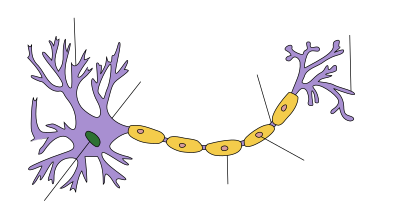Neuronal firing
| Neuron |
|---|
In physiology, an action potential occurs when the membrane potential of a specific axon location rapidly rises and falls: this depolarisation then causes adjacent locations to similarly depolarise. In the Hodgkin–Huxley (HH) model of Alan Lloyd Hodgkin and Andrew Fielding Huxley, speed of transmission of an action potential was undefined and it was assumed that adjacent areas became depolarised due to released ion interference with neighbouring channels. Measurements of ion diffusion and radii have since shown this to not be possible. Moreover, contradictory measurements of entropy changes and timing disputed the HH as acting alone. More recent work has shown that the HH action potential is not a single entity but is a coupled synchronised oscillating lipid pulse (action potential pulse) powered by entropy from the HH ion exchanges.
Action potentials occur in several types of animal cells, called excitable cells, which include neurons, muscle cells, and endocrine cells, as well as in some plant cells. In neurons, action potentials play a central role in cell-to-cell communication by providing for (or assisting in, with regard to saltatory conduction) the propagation of signals along the neuron's axon towards boutons at the axon ends which can then connect with other neurons at synapses, or to motor cells or glands. In other types of cells, their main function is to activate intracellular processes. In muscle cells, for example, an action potential is the first step in the chain of events leading to contraction. In beta cells of the pancreas, they provoke release of insulin. Action potentials in neurons are also known as "nerve impulses" or "spikes", and the temporal sequence of action potentials generated by a neuron is called its "spike train". A neuron that emits an action potential is often said to "fire".
...
Wikipedia

